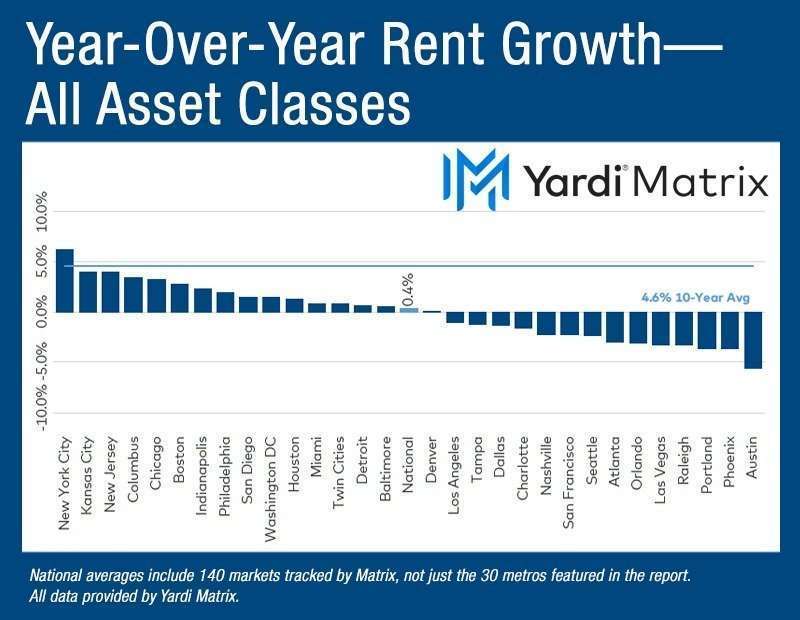
Year-over-year rent growth remained unchanged at 0.4 percent, according to Yardi Matrix.
Year-over-year multifamily rent growth, all asset classes. Chart courtesy of Yardi Matrix
The seasonal winter slowdown led to tepid performance across the U.S. multifamily market, with the average national asking rent declining $6 to $1,713 in November, down for the third consecutive month, according to the Yardi Matrix’s latest survey of 140 markets. On a year-over-year basis, the U.S. rate rose 0.4 percent, unchanged from September. Meanwhile, the occupancy rate remained at 94.9 percent. Rents declined in the SFR segment, too, down $8 to $2,117 in November, for a 0.7 percent year-over-year increase. Occupancy was unchanged in October, at 94.9 percent.
Since March 2020, the average asking rent increased 23.5 percent, boosted by markets in the Sunbelt and the suburbs of primary metros. Examples include low-cost and fast-growing metros such as Knoxville (51.5 percent), Albuquerque (45.5 percent), Savannah (44.9 percent), Charleston (41.8 percent) and Mobile (40.7 percent); second and retirement homes areas such as Southwest Florida Coast (49.1 percent), West Palm Beach (43.3 percent) and Asheville, N.C. and Tucson (both 40.1 percent). Large and expensive markets saw the smallest growth (San Jose (4.0 percent), Urban Los Angeles (10.3 percent), New York City (12.0 percent), Urban Chicago (14.4 percent) and Urban Philadelphia (16.9 percent). More so, Urban San Francisco is the only market with rents below pre-pandemic levels (-2.5 percent).
Rent growth split geographically between gains and losses
Rent performance was uneven across the map but balanced enough between year-over-year gains and losses. Among Yardi Matrix’s top 30 metros, the Northeast and Midwest regions led gains, with New York City (6.2 percent year-over-year), Kansas City (4.0 percent), New Jersey (4.0 percent), Columbus (3.4 percent) and Chicago (3.2 percent) posting the highest advances. In contrast, Sunbelt and West metros lagged. More so, negative rent growth is intensifying, with seven of Yardi Matrix’s top 30 metros posting rent contractions of 3.0 percent or more year-over-year, with most of these located in Sunbelt markets where developers brought online robust volumes of deliveries. Occupancy declined or remained flat year-over-year as of October in all but four markets: Chicago (up 0.4 percent), Denver (0.3 percent), Seattle (0.1 percent) and Washington, D.C. (0.1 percent). Atlanta posted the largest occupancy decrease down 1.3 percent.
On a monthly basis, the U.S. multifamily asking rent declined 0.3 percent in November, down 0.2 percent in the Renter-by-Necessity segment and down 0.4 percent in the Lifestyle segment. Specifically, rent growth was negative in 27 of the top 30 metros in Lifestyle and 20 in the RBN segment. The largest declines in both segments were recorded in Raleigh (-1.1 percent in Lifestyle and -1.3 percent in RBN) and Charlotte (-0.9 percent in Lifestyle and -1.1 percent in RBN). Only five metros posted gains in month-over-month rent growth, led by Kansas City (0.6 percent), New York (0.5 percent) and Houston (0.4 percent). Austin, Nashville and Charlotte led in completions as a percentage of stock, which caused significant rent and occupancy declines.
Renewal rent growth moderated to 6.0 percent year-over-year in September, down 40 basis points from August. With a few exceptions, the highest renewal rents were in metros where asking rents increased, such as New York (8.2 percent), Boston (7.4 percent), Indianapolis (7.2 percent), Kansas City (6.9 percent) and New Jersey (6.8 percent). Bottom-ranking metros were San Francisco (2.5 percent), Phoenix (2.6 percent) and Dallas (3.2 percent)—in these metros asking rents turned negative. Meanwhile, the national lease renewal rate clocked in at 65.2 percent in September, hovering between 64.7 percent and 66.0 percent for the last five months. The highest rate was recorded in New Jersey (81.5 percent) and the lowest in Los Angeles (47.6 percent).
Single-family rents declined $8 in November to $2,115, a 0.7 percent year-over-year increase, down 30 basis points from October, marking the largest one-month decrease in years. Rent growth was entirely sustained by the RBN segment, up 3.2 percent year-over-year, while lifestyle rents slid 0.1 percent during the period. Meanwhile, occupancy stood at 95.9 percent for the fifth consecutive month in October. According to Yardi Matrix’s database, 58,000 SFR properties were under construction in November. Leading in construction pipelines were Jacksonville (2,256 units underway), Orlando (1.365 units), Savannah, Ga. (1.343 units), and Huntsville, Ala. (1,142 units).
Source: National Multifamily Report – November 2023
https://www.creconsult.net/market-trends/national-multifamily-report-november-2023/
No comments:
Post a Comment